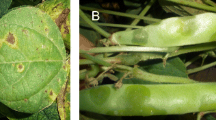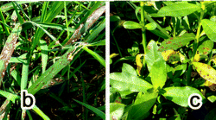Abstract
Kiwifruit bacterial canker (KBC) caused by Pseudomonas syringae pv. actinidiae (Psa) is a worldwide epidemic. Forty-seven strains of Psa in Biovar 3 from different geographic regions in the world, thirty-seven of them collected in China, were selected to study genetic variation by using Rep-, RAPD- and IS50- PCR assays. Twenty-two strains of Chinese Psa were selected to test the fluorescence of each strain when grown on King’s B (KB) medium and examined under UV light, the pathogenicity of seven representative strains of Chinese Psa isolated from different provinces or cultivars was tested by the foliage spray inoculation of three cultivars with different tolerances to KBC. Twenty-eight of the main cultivars were subjected to a tolerance assay by wound inoculation on vines in vivo. The results showed that Chinese Psa Biovar 3 strains have a broad genetic variability related to their different geographic regions, Chinese Psa Biovar 3 strains had faint to brighter fluorescence (ΔE = 0.25–1.00, GFI = 1–3), although they were suggested to lack fluorescence in the past. Schy4 and JF8 were the most virulent; GC40, Hwd1 and Sh13 were the least virulent; and Jzhy2 and Jzzm2 were moderately virulent among the strains tested in this study. According to the combined data of necrosis length when inoculated with each of the three Chinese Psa strains (Schy4, Hwd1 and Jzhy2), the tolerance of the 28 tested cultivars to KBC could be divided into three grades. In conclusion, there were significant differences in the fluorescence and pathogenicity of Chinese Psa strains, but the fluorescence emission is not correlated with the virulence and pathogenicity of strains in this study. It was proposed that such cultivars as ‘Wanjin’, ‘Donghong’, ‘Huate’, ‘Fujianmaohua’, ‘Ganmi No. 6’, ‘Hongguoruanzao’, ‘Ruanzao No. 2’ and ‘Jialv’ kiwifruit could be used as parental materials to breed new cultivars tolerant to KBC in future kiwifruit production.



Similar content being viewed by others
References
Abelleira A, López MM, Peñalver J et al (2011) First report of bacterial canker of kiwifruit caused by Pseudomonas syringae pv. Actinidiae in Spain. Plant Dis 95(12):1583
Balestra GM, Mazaglia A, Quattrucci A et al (2009a) Current status of bacterial canker spread on kiwifruit in Italy. Aust Plant Dis Notes 4:34–36
Balestra GM, Mazaglia A, Quattrucci A et al (2009b) Occurrence of Pseudomonas syringae pv. Actinidiae in Jin Tao kiwi plants in Italy. Phytopathol Mediterr 48(2):299–301
Balestra GM, Renzi M, Mazzaglia A (2010) First report of bacterial canker of Actinidia deliciosa caused by Pseudomonas syringae pv. Actinidiae in Portugal. New Dis Rep 22:10
Bastas KK, Karakaya A (2012) First report of bacterial canker of kiwifruit caused by Pseudomonas syringae pv. actinidiae in Turkey. Plant Dis 96:452
Cunty A, Poliakoff F, Rivoal C, Cesbron S, Fischer-Le Saux M, Lemaire C (2015a) Characterization of Pseudomonas syringae pv. actinidiae (Psa) isolated from France and assignment of Psa biovar 4 to a de novo pathovar: Pseudomonas syringae pv. actinidifoliorum pv. Nov. Plant Pathol 64:582–596. https://doi.org/10.1111/ppa.12297
Cunty A, Cesbron S, Poliakoff F, Jacques M-A, Manceau C (2015b) Origin of the outbreak in France of Pseudomonas syringae pv. actinidiae biovar 3, the causal agent of bacterial canker of kiwifruit, revealed by a multilocus variable-number tandem-repeat analysis. Appl Environ Microbiol 81:6773–6789
Dreo T, Pirc M, Ravnikar M, Žežlina I, Poliakoff F, Rivoal C, Nice F, Cunty A (2014) First report of Pseudomonas syringae pv. actinidiae, the causal agent of bacterial canker of kiwifruit in Slovenia. Plant Dis 98(11):1578–1578
EPPO. 2011a. First report of Pseudomonas syringae pv. actinidiae in Australia. EPPO rep. Serv. 6:2011/130
EPPO. 2011b. First report of Pseudomonas syringae pv. actinidiae in Switzerland. EPPO rep. Serv. 8:2011/168
EPPO. 2013. First report of Pseudomonas syringae pv. actinidiae in Germany. EPPO rep. Serv. 9:2013/185
Everett KR, Taylor RK, Romberg RK, Rees-George J, Fullerton RA, Vanneste JL, Manning MA (2011) First report of Pseudomonas syringae pv. actinidiae causing kiwifruit bacterial canker in New Zealand. Australas. Plant Dis Notes 6:67–71
Fang YZ, Zhu XX, Wang YD (1990) Preliminary study on the kiwifruit disease in Hunan province. Sichuan Fruit Science and Technology 18:28–29 (in Chinese)
Ferguson AR, Huang H (2007) Genetic resources of kiwifruit: domestication and breeding. Hortic Rev 33:1–121. https://doi.org/10.1002/9780470168011.ch1
Ferrante P, Scortichini M (2010) Molecular and phenotypic features of Pseudomonas syringae pv. actinidiae isolated during recent epidemics of bacterial canker on yellow kiwifruit (Actinidia chinensis) in Central Italy. Plant Pathol 59:954–962
Ferrante P, Scortichini M (2015) Redefining the global populations of Pseudomonas syringae pv. actinidiae based on pathogenic, molecular and phenotypic characteristics. Plant Pathol 64:51–62
Ferrante P, Takikawa Y, Scortichini M (2015) Pseudomonas syringae pv. actinidiae strains isolated from past and current epidemics to Actinidia spp. reveal a diverse population structure of the pathogen. Eur J Plant Pathol. https://doi.org/10.1007/s10658-015-0643-6
Han HS, Koh YJ, Hur JS, Jung JS (2003) Identification and characterization of coronatine-producing Pseudomonas syringae pv. actinidiae. J Microbiol Biotechnol 13:110–118
He R, Liu P, Jia B, Xue S, Wang X, Hu J, Al Shoffe Y, Gallipoli L, Mazzaglia A, Balestra GM, Zhu L (2019) Genetic diversity of Pseudomonas syringae pv. actinidiae strains from different geographic regions in China. Phytopathology, Published online: 21 Feb 2019. https://doi.org/10.1094/PHYTO-06-18-0188-R
Koh YJ, Kin GH, Jung JS, Lee YS, Hur JS (2010) Outbreak of bacterial canker on Hort16A (Actinidia chinensis Planchon) caused by Pseudomonas syringae pv. actinidiae in Korea. New Zealand J Crop Hort Sci 38(4):275–282
Koh YJ, Kim GH, Koh HS, Lee YS, Kim SC, Jung JS (2012) Occurrence of a new type of Pseudomonas syringae pv. actinidiae strain of bacterial canker on kiwifruit in Koreax. J Plant Pathol 28:423–427
Koh HS, Kim GH, Lee YS, Koh YJ, Jung JS (2014) Molecular characteristics of Pseudomonas syringae pv. actinidiae strains isolated in Korea and a multiple PCR assay for haplotype differentiation. J Plant Pathol 30(1):96–101
Li M, Tan GJ , Li Y, Ding KJ , Chan ZL, Ling Y. 2009. Relationships between the contents of phenolics, soluble proteins in plants of kiwifruit cultivars and their tolerance to kiwifruit bacterial canker by Pseudomonas syringae pv. actinidiae. Plant Protection, 35(1):37-41 (In Chinese).
Li M, Tan GJ, Li Y, Chang HY, Li K, Chen CP (2003) Relationship between the shoot tissue structure of kiwifruit cultivars and bacterial canker disease tolerance. Journal of Anhui Agricultural University 30(3):240–245 (In Chinese)
Liu P, Xue S, He R, Hu J, Wang X, Jia B, Gallipoli L, Mazzaglia A, Balestra GM, Zhu L (2016) Pseudomonas syringae pv. actinidiae isolated from non-kiwifruit plant species in China. Eur J Plant Pathol 145:743–754. https://doi.org/10.1007/s10658-016-0863-4
Mazarei M, Mostofipour P (1994) First report of bacterial canker of kiwifruit in Iran. Plant Pathol 43:1055–1056
Mazzaglia A, Studholme DJ, Taratufolo MC, Cai R, Almeida NF, Goodman T, Balestra GM (2012) Pseudomonas syringae pv. actinidiae (PSA) isolates from recent bacterial canker of kiwifruit outbreaks belong to the same genetic lineage. PLoS One 7:e36518
McCann C, Honour L, Li Y, Liu D, Li H, Pan CZ, Erik HA, Rikkerink M, Templeton D, Straub C, Colombi E, Rainey PB, Huang H (2017) Origin and evolution of the kiwifruit canker pandemic. Genome Biol Evol 9(4):932–944. https://doi.org/10.1093/gbe/evx055
SAG. 2011. First report of bacterial canker of kiwifruit in Chile. Government of Chile. http://www.cooperativa.cl/sag-prepara-plan-de-contingencia-tras-deteccion-de-enfermedad-del-kiwi-en-chile/prontus_nots/2011-03-22/093651.html (in Chilean)
Sawada H, Miyoshi T, Ide Y (2014) Novel MLSA group (Psa5) of Pseudomonas syringae pv. actinidiae causing bacterial canker of kiwifruit (Actinidia chinensis) in Japan. Jap J Phytopathol 80:171–184
Sawada H, Kondo K, Nakaune R (2016) Novel biovar (biovar 6) of Pseudomonas syringae pv. actinidiae causing bacterial canker of kiwifruit (Actinidia deliciosa) in Japan. Jpn. J. Phytopathol. 82:101–115
Sawada H, Fujikawa T, Kita N, Orihara N, Shinozaki T, Shimizu S, Nakaune R, Takikawa Y (2017) Characteristics of Pseudomonas syringae pv. actinidifoliorum causing bacterial leaf spot of Actinidia spp. in Japan. Jpn J Phytopathol. https://doi.org/10.3186/jjphytopath.83.136
Scortichini M (1994) Occurrence of Pseudomonas syringae pv. Actinidiae on kiwifruit in Italy. Plant Pathol 43:1035–1038
Serizawa S, Ichikawa T, Takikawa Y, Tsuyumu S, GotoM (1989) Occurrence of bacterial canker of kiwifruit in Japan: description of symptoms, isolation of the pathogen and screening of bactericides. Ann Phytopathol Soc Jpn 55:427–436
Tu X, Shen Z, Gao ZP, Kang ZS, Huang LL (2011) Investigation of kiwifruit bacterial canker disease (Pseudomonas syringae pv. actinidiae Takikawa.) in Guanzhong area of Shannxi Province and its biological control. Plant Dis Pests 2:17–20
Vanneste J, Poliakoff F, Audusseau C et al (2011) First report of Pseudomonas syringae pv. Actinidiae the causal agent of bacterial canker of kiwifruit on Actinidia deliciosa in France. Plant Dis 95(10):1311
Vanneste JL, Yu J, Cornish DA, Tanner DJ, Windner R, Chapman JR, Taylor RK, Mackay J, Dowlut S (2013) Identiication, virulence and distribution of two biovars of Pseudomonas syringae pv. actinidiae in New Zealand. Plant Dis 97:708–719
Zhao ZB, Gao XN, Huang QL, Huang LL, Qin HQ, Kang ZS (2013) Identification and characterization of the causal agent of bacterial canker of kiwifruit in the Shaanxi province of China. J Plant Pathol 95:155–162
Acknowledgements
The authors thank Prof. Giorgio M. Balestra, Department of Science and Technologies for Agriculture, Forestry, Nature and Energy (DAFNE), University of Tuscia, Viterbo, Italy, providing us the reference strains of Psa pathovars from different geographic regions except for China; and Mr. WANG Mou-cai, Institute of Wanxi Kiwifruit, Huoqiu County, Anhui Province, China providing us the kiwifruit two-years-old grafted young plants for strain pathogenicity and cultivar tolerance test.
Funding
This study was funded by Excellent Young Talents Fund Program of Higher Education Institutions of Anhui Province (gxfxZD2016023).
Author information
Authors and Affiliations
Corresponding author
Ethics declarations
Conflict of interest
The authors have declared that no potential conflicts of interest exist.
This article does not contain any studies with human participants or animals performed by any of the authors.
Additional information
Publisher’s note
Springer Nature remains neutral with regard to jurisdictional claims in published maps and institutional affiliations.
Electronic supplementary material
ESM 1
(DOCX 1605 kb)
Rights and permissions
About this article
Cite this article
Ye, Zf., Wei, Pf., Xue, Sz. et al. Characterization of Pseudomonas syringae pv. actinidiae Biovar 3 strain and cultivar tolerance to kiwifruit bacterial canker in China. J Plant Pathol 102, 443–450 (2020). https://doi.org/10.1007/s42161-019-00459-4
Received:
Accepted:
Published:
Issue Date:
DOI: https://doi.org/10.1007/s42161-019-00459-4




